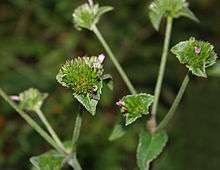Elephantopus scaber
| Elephantopus scaber | |
|---|---|
 | |
| Elephantopus scaber in India | |
| Scientific classification | |
| Kingdom: | Plantae |
| (unranked): | Angiosperms |
| (unranked): | Eudicots |
| (unranked): | Asterids |
| Order: | Asterales |
| Family: | Asteraceae |
| Genus: | Elephantopus |
| Species: | E. scaber |
| Binomial name | |
| Elephantopus scaber L. | |
| Synonyms[1] | |
| |
Elephantopus scaber is a tropical species of flowering plant in the sunflower family. It is native to tropical Africa, Eastern Asia, Indian Subcontinent, Southeast Asia, and northern Australia. It has become naturalized in tropical Africa and Latin America. Its natural habitat is subtropical or tropical moist montane forests.[2][3][4][5][6][7][8]
Uses
E. scaber is used as a traditional medicine.[9] Different parts of the plant are used in traditional medicine of India as an astringent agent, cardiac tonic, and diuretic, and is used for eczema, rheumatism, fever, and bladder stones.[10]
Chemical constituents
E. scaber contains elephantopin which is a germacranolide sesquiterpene lactone containing two lactone rings and an epoxide functional group.[11][12] 17,19-dihydrodeoxyelephantopin, iso-17,19- dihydro-deoxy elephantopin and 8-hydroxyl Naringenin are the most important bioactive compounds responsible for anti-bacterial activity.[13]
Subspecies and varieties
Varieties of E. scaber include:[1]
- Elephantopus scaber subsp. plurisetus (O.Hoffm.) Philipson
- Elephantopus scaber subsp. scaber
- Elephantopus scaber var. scaber
- Elephantopus scaber var. sinuatus (Mor.) Miq.
References
- 1 2 The Plant List, Elephantopus scaber L.
- ↑ Flora of China, 地胆草 di dan cao Elephantopus scaber Linnaeus, Sp. Pl. 2: 814. 1753.
- ↑ Atlas of Living Australia, Elephantopus scaber L.
- ↑ Breedlove, D.E. 1986. Flora de Chiapas. Listados Florísticos de México 4: i–v, 1–246.
- ↑ Humbert, H. 1960. Composées. Fl. Madagasc. 189: 198-199 description in French
- ↑ Humbert, H. 1960. Composées. Fl. Madagasc. 189: plate I (1), figures 10-12 at right line drawings of Elephantopus scaber
- ↑ Jeffrey, C. 1988. Notes on Compositae: V. The Vernonieae in East Tropical Africa. Kew Bulletin 43(2): 195–277.
- ↑ Nelson, C. H. 2008. Catálogo de las Plantas Vasculares de Honduras 1–1576. Secretaria de Recursos Naturales y Ambiente, Tegucigalpa.
- ↑ Poli, A; Nicolau, M; Simoes, Cm; Nicolau, Rm; Zanin, M (Aug 1992). "Preliminary pharmacologic evaluation of crude whole plant extracts of Elephantopus scaber. Part I: in vivo studies". Journal of Ethnopharmacology. 37 (1): 71–6. doi:10.1016/0378-8741(92)90005-C. ISSN 0378-8741. PMID 1453704.
- ↑ Wang, Limei; Waltenberger, Birgit; Pferschy-Wenzig, Eva-Maria; Blunder, Martina; Liu, Xin; Malainer, Clemens; Blazevic, Tina; Schwaiger, Stefan; Rollinger, Judith M.; Heiss, Elke H.; Schuster, Daniela; Kopp, Brigitte; Bauer, Rudolf; Stuppner, Hermann; Dirsch, Verena M.; Atanasov, Atanas G. (2014). "Natural product agonists of peroxisome proliferator-activated receptor gamma (PPARγ): A review". Biochemical Pharmacology. 92 (1): 73–89. doi:10.1016/j.bcp.2014.07.018. PMC 4212005
 . PMID 25083916.
. PMID 25083916. - ↑ "Antitumor activity of elephantopus scaber linn against dalton's ascitis lymphoma". Indian Journal of Pharmaceutical Sciences. 64 (1): 71–3. Jan–Feb 2002.
- ↑ "Elephantopus scaber L.". National Germplasm Resources Laboratory, Beltsville, Maryland: USDA, ARS, National Genetic Resources Program. Germplasm Resources Information Network - (GRIN) [Online Database]. Retrieved 7 May 2011.
- ↑ Aslam, Muhammad Shahzad; Ahmad, Muhammad Syarhabil; Mamat, Awang Soh. "Anti-microbial potential of Elephantopus scaber - an updated review" (PDF). Indian Research Journal of Pharmacy and Science. 2 (4): 315–322.
